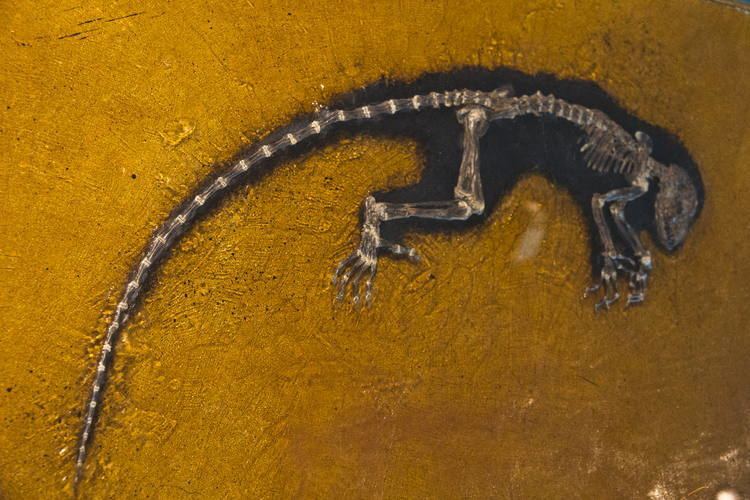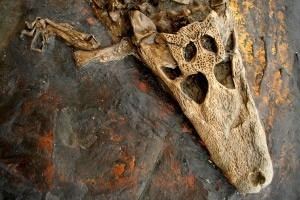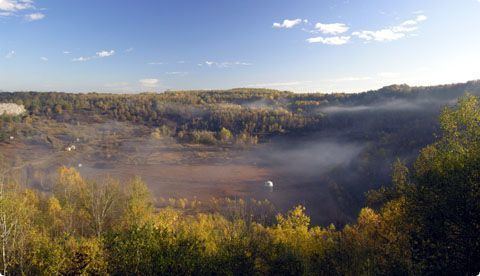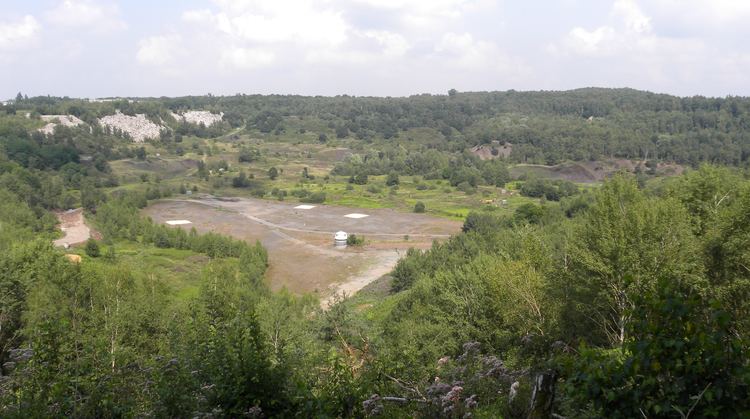Type Natural Reference 720 | Criteria viii UNESCO World Heritage Site inscription 1995 | |
UNESCO region Europe and North America Similar Lorsch Abbey, Naturmuseum Senckenberg, Maulbronn Monastery, Dessau‑Wörlitz Garden Realm, Augustusburg and Falkenlus | ||
The Messel Pit (German: Grube Messel) is a disused quarry near the village of Messel, (Landkreis Darmstadt-Dieburg, Hesse) about 35 km (22 mi) southeast of Frankfurt am Main, Germany. Bituminous shale was mined there. Because of its abundance of fossils, it has significant geological and scientific importance. After almost becoming a landfill, strong local resistance eventually stopped these plans and the Messel Pit was declared a UNESCO World Heritage site on 9 December 1995. Significant scientific discoveries are still being made and the site has increasingly become a tourism site as well.
Contents
- The messel pit
- HistoryEdit
- Depositional characteristicsEdit
- Volcanic gas releasesEdit
- FossilsEdit
- MammalsEdit
- BirdsEdit
- ReptilesEdit
- FishEdit
- InsectsEdit
- PlantsEdit
- AccessEdit
- References

The messel pit
HistoryEdit

Brown coal and later oil shale was actively mined from 1859. The pit first became known for its wealth of fossils around 1900, but serious scientific excavation only started around the 1970s, when falling oil prices made the quarry uneconomical. Commercial oil shale mining ceased in 1971 and a cement factory built in the quarry failed the following year. The land was slotted for use as a landfill, but the plans came to nought and the Hessian state bought the site in 1991 to secure scientific access. In the few years between the end of mining and 1974, when the state began preparing the site for garbage disposal, amateur collectors were allowed to collect fossils. The amateurs developed the "transfer technique" that enabled them to preserve the fine details of small fossils, the method still employed in preserving the fossils today.

Due to the extraordinary fossils, the pit was declared a UNESCO world heritage site in 1995, one of the few sites that have ever been placed on the list exclusively due to fossils.

Many of the known specimens from the site have come from amateur collectors and in 1996, an amnesty on previously collected fossils was put in effect, in the hope of getting privately owned collections back into public ownership and available to science.
Depositional characteristicsEdit
The current surface of the Messel pit is roughly 60 m (200 ft) below the local land and is about 0.7 km2 (0.27 sq mi) in area. The oil-shale bed originally extended to a depth of 190 m (620 ft). 47 million years ago in the Eocene when the Messel deposits formed, the area was 10° further south than it is now. The period was very close to the Paleocene–Eocene Thermal Maximum and the climate and ecology of the site were very different. A large series of lakes, surrounded by lush sub-tropical forests supported an incredible diversity of life. The Messel lake bed was probably a center point for drainage from nearby rivers and creeks.
The pit deposits were formed during the Eocene Epoch of the Paleogene Period about 47 million years ago, based on dating of basalt fragments underlying fossilbearing strata. Oil shale, formed by the slow anoxic deposition of mud and dead vegetation on the lake bed, is the primary rock at the site. Its sediments extend 13 m (43 ft) downward and lie atop an older sandstone foundation. The fossils within the shale show a remarkable clarity and preservation due to the unique depositional characteristics of the lake and so the Messel pit represents a Konservat-Lagerstätten. The upper stratifications of the lake most certainly supported a variety of organisms, but the bottom was subject to little disturbance by current, spawning a very anoxic environment. This prevented many epifaunal and infaunal species from inhabiting this niche and thus bioturbation was kept at a minimum. Overturn of the lake layers (caused by seasonal variations) lowered oxygen content near the surface and led to a periodic "die-off" of aquatic species. Combined with a relatively low rate of deposition, 0.1 mm (0.0039 in) per year, this provided a prime environment for the preservation of fauna and flora.
Volcanic gas releasesEdit
The area around the Messel Pit is believed to have been geologically and tectonically active during the Eocene. Leading scientists hypothesize that events much like the 1986 volcanic gas releases at Lake Nyos, Cameroon could account for the large deposition of non-aquatic species. Periodic subsurface shifts possibly released large concentrations of reactive gases (such as carbon dioxide and hydrogen sulfide) into the lake and adjoining ecosystems, killing susceptible organisms. During these releases, birds and bats might have fallen in if near the lake surface and terrestrials could be overwhelmed when near the lake shore. Since the lake was very deep, animals that fell in it drifted downwards into oxygen- and bacteria-poor water, where they were preserved remarkably well, being overlaid by successive layers of mud that petrified later, thus producing an aggregation of fossils of exceptional quality, quantity, integrity, and variety.
FossilsEdit
The Messel Pit provides the best preserved evidence of Geiseltalian flora and fauna so far discovered. Most other sites are lucky to contain partial skeletons, but Messel boasts extensive preservation of structural integrity, even going so far as to preserve the fur, feathers and "skin shadows" of some species. Unusual preservation has sparked some closely reasoned interpretations. The symptomatic "dumb-bell"-shaped bite marks on either side of the leaf vein on a fossilised leaf have been identified as the death-grip of a carpenter ant terminally parasitized by the fungus Ophiocordyceps unilateralis, that, apparently then as today, commandeered its behavior, in order to release its spores from a favourable location; it is the earliest concrete sample of fungal behavioural manipulation.
The diversity of species is remarkable partly as a result of the hypothesized periodic gas releases. A brief summary of some of the fossils found at the site follows:
The following is only a partial list:
MammalsEdit
Darwinius masillae, identified in 2009 as an adapiform primateKopidodon, an extinct arboreal cimolestanLeptictidium, an extinct omnivorous hopping mammal (of the leptictid family)Propalaeotherium, an early relative of horsesAiluravus, a rodentPeradectes, a metatherianPalaeochiropteryx, a batLesmesodon, a small hyaenodontidEomanis, an early pangolinEurotamandua, a scaleless, anteater-like pangolinEuropolemur, a primateParoodectes, an early carnivorous mammalPholidocercus, an early hedgehogMacrocranion, an early long-tailed hedgehogMasillamys, an early rodentMesselobunodon, an early artiodactylGodinotia, an early primateBuxolestes, a semiaquatic, otter-like cimolestanBirdsEdit
Palaeotis, an early struthionidStrigogyps sapea (formerly Aenigmavis) a cariamiformMesselornis, the Messel-bird; a species of gruiformMasillastega, a freshwater sulidLapillavis, a possible trogonid relativeCypseloramphus, a basal apodiformThe Messelasturidae (Messelastur and Tynskya), carnivorous relatives of modern parrotsPalaeoglaux, an early owl with enigmatic breast feathersParaprefica, an early potooMasillaraptor, an early falconiformParargornis, an early apodiformMesselirrisor, a tiny bucerotiform closely related to hoopoes and wood-hoopoesSelmes (an anagram of "Messel"), a mousebird with stubby toesGastornis (formerly Diatryma), a large, flightless anseriformA currently unnamed lithornithid, a sandpiper-like paleognath, the first record of its kind in Middle Eocene Europe.ReptilesEdit
Asiatosuchus, a large crocodileDiplocynodon, an alligatorHassiacosuchus, a durophagous crocodilePalaeopython, a snakeCryptolacerta, a lizard with affinities to amphisbaeniansGeiseltaliellus, a lizard with affinities to CorytophaninaeAllaeochelys crassesculpta, turtlesFishEdit
A bowfin, variously described as Amia (the modern genus) or CyclurusAmphiperca, an early perchPalaeoperca, another early perchAtractosteus, a gareelInsectsEdit
Gesomyrmex pulcherTitanomyrma giganteaTitanomyrma simillimajewel beetlestag beetlerove beetlePlantsEdit
Ailanthus confucii, tree of heavenAnacardium germanicum, cashew treeCamelliacarpoidea messelensis, Messel camelliaCanarium, member of the incense tree familyCyclanthus messelensis, panama hat familyMyristicacarpum, member of the nutmeg familyDarmstadtia biseriata, a member of the trumpet creeper family BignoniaceaeMytilaria boglei, witch-hazel familySloanea messelensis, ElaeocarpaceaeAccessEdit
Exhibits from the pit may be seen in the Messel town museum, the Museum of Hessen in Darmstadt (5 km from Messel) and also the Senckenberg Museum in Frankfurt-am-Main (some 30 km from Messel). Casual visitors can park close to the pit and walk around 300 m to a viewing platform overlooking the pit. Entrance to the pit is only possible as part of a specially organized tour.
